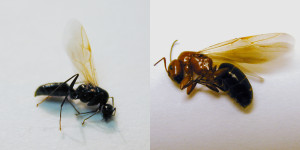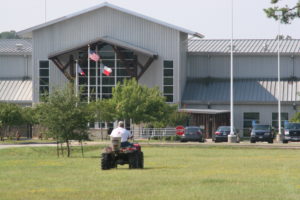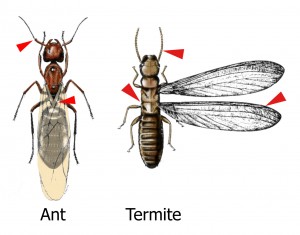As the rain falls, so does our chances to bring a wide variety of pests into our homes and schools. Two of the most common for spring are termites and ants.
As April approaches so does the emergence of termites. Termites that swarm are actually doing building maintenance a favor. While you may find the idea crazy that termite swarming is doing you a favor, understanding termite biology will make the idea more acceptable.
Termites can damage buildings undetected for a long time because of their secretive, underground habits. The one time of year that termites are most likely to alert people to their presence is swarming season. Termites would do a lot more damage to buildings without evidence of the swarms because problems would go undetected and untreated for longer periods of time.
Termite swarming can start in January and February in South Texas and be as late as April and May up in the Panhandle.
IPM Coordinators must be familiar with the appearance and behavior of termite swarmers, and should encourage maintenance and custodial staff to report termite swarmers immediately. Because swarmers disappear as quickly as they appear, it is too easy to assume the problem is also gone. The presence of swarmers indoors is a sure sign of an active termite infestation.
In most parts of Texas termite swarming activity starts with the construction of a swarm tube in late March or early April. A swarm tube looks innocent enough at initial formation – a small dab of mud or dirt appearing mysteriously on an indoor wall. Within a week or two, however, when the weather conditions are right, the tiny hole becomes a doorway for dozens to thousands of termite swarmers.
Fortunately, the thousands of termite swarmers emerging into a school office or classroom do not contribute to the indoor spread of termites. Subterranean termite swarmers that emerge indoors are unlikely to actually start a new colony. Because they cannot reach soil, any swarmers that emerge indoors quickly die. However, the IPM coordinator or building manager needs to investigate and inspect the area where the termites swarmed to determine if an active termite colony is in the building. The inspection can wait until classes end for the day or for thorough inspection you may wait until the school year ends. You should call in a pest professional to conduct a thorough inspection and treatment. There are several treatment options, for more information about termites, check out our Urban Entomology website.
The following diagram may be used to train school maintenance staff in how to distinguish between ants and termites.
| Winged Ants | Winged Termites |
| two pairs of wings, hind wings shorter | two pairs of wings of equal size and shape |
| elbowed antennae | hair-like antennae |
| narrow “waist” between abdomen and thorax | no narrow waist |
Spring is also the time for many of our nuisance ant species to swarm as well. Carpenter ants are bicolored ants that are among the largest ants found in Texas, making their swarms dramatic. There are fourteen species of carpenter ants that occur in Texas.
Common indoor species, Camponotus rasilis Wheeler and C. sayi Emery, have workers that are dull red bodied with black abdomens. Worker ants range in size from 1/4 to 1/2-inch. They can be distinguished from most other large ant species because the top of the thorax is evenly rounded and bears no spines.

Male (left) and female carpenter ant swarmers. Note the pinched waist that distinguishes these insects from termites.
These ants usually nest in dead wood, either outdoors in old stumps and dead parts of trees and around homes (in fences, fire wood, etc.) or indoors (between wood shingles, in siding, beams, joists, fascia boards, etc.). Ant colonies are often located in cracks and crevices between structural timbers, but the ants can also tunnel into structural wood to form nesting galleries. They often appear to prefer moist, decaying wood, wood with dry rot or old termite galleries. Sometimes teachers and school administrators are concerned about damage to the structural integrity of the building because they think they might be dealing with a termite swarm. However, damage is often limited because these ants tunnel into wood only to form nests and do not eat wood. Galleries (nesting tunnels) produced by carpenter ants usually follow the grain of the wood and around the annual rings. Tunnel walls are clean and smooth. Nests can be located by searching for piles of sawdust-like wood scrapings (frass) underneath exit holes.
The odorous house ant, Tapinoma sessile, is considered a pest when it enters structures searching for food, water or nest sites. It cannot sting because it lacks a stinger and will likely only bite if you stick a hand into its nest and vigorously disturb the colony. Occasionally winged reproductives ants found at lights concern people as well. Odorous house ant is common throughout the United States and is the second most common pest ant managed by professionals! This ant is about 1/8-inch long, dark brown to black and smells like rotten coconut with a hint of other odors when crushed, which gives it some other names like “piss ant”.
In addition to their smell, odorous house ants are accurately named as they are often found foraging along the outside base of a home. Increased indoor activity is often associated with rain. Odorous house ant activity can be observed during the day and night and will be found foraging outdoors in greatest numbers when temperatures are between 70 and 86 degrees F. Odorous house ants use edges, ridges or other guidelines to move from one place to another. Natural (vines, trees and shrubs) and man-made (siding, ground/foundation wall interface, wires, pipes, conduits, baseboards, counters and others) objects may serve as guidelines.
This ant will respond to baits for more information check out this fact sheet from University of Tennessee by Karen Vail and Jennifer Chandler.

To control fire ants on school campuses it is recommended that you broadcast bait using an appropriate spreader.
Another common foe is the red imported fire ant (Solenopsis invicta) which is common in all southern states. As the weather continues to warm up, fire ant activity will also warm up. Initial imported fire ant mounds are usually found near sidewalks or slabs. This is especially true in the cool spring because these areas presumably warm up sooner. These ants are aggressive and once encountered can result in stings, equipment failure and unsightly fields.
Despite the warm days with air temperatures in the 80s and 90s, soil temperatures are just climbing to levels where fire ants are foraging for food. This means that in some areas it may still be a little early for applying fire ant bait. Currently the soil temperatures ranged from mid-60s to the mid-70s here at the Dallas office. Research indicates that fire ant foraging doesn’t begin in earnest until soil temperatures reach the 70 degree mark. Our standard recommendation is to hold off bait applications until May.
While baits are still the most cost-effective and environmentally sensitive option for area-wide fire ant control, mound treatments are effective for controlling visible mounds and can be applied any time of year. Mound treatments are ideally used against fire ant nests that need quick control, like mounds next to the school or in other inconvenient locations. For more information about fire ants and fire ant control, you can go to the Fire ant website or check out fire ant management plan.
Finally if you would like to confirm if your pest management professional is using a Green or Yellow category product, you can go to our Fact Sheet Recognizing Green Category Pesticides – a fact sheet for how to ID Green products to learn more about Green Category choices.
This article is a combination of documents and information from eXtension, Mike Merchant, Wizzie Brown, Molly Keck, Paul Nester and Janet Hurley.




 .
.